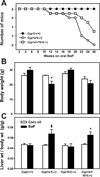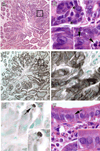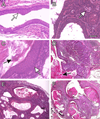Oral benzo[a]pyrene-induced cancer: two distinct types in different target organs depend on the mouse Cyp1 genotype
- PMID: 20127859
- PMCID: PMC2917638
- DOI: 10.1002/ijc.25222
Oral benzo[a]pyrene-induced cancer: two distinct types in different target organs depend on the mouse Cyp1 genotype
Abstract
Benzo[a]pyrene (BaP) is a prototypical polycyclic aromatic hydrocarbon (PAH) found in combustion processes. Cytochrome P450 1A1 and 1B1 enzymes (CYP1A1 and CYP1B1) can both detoxify PAHs and activate them to cancer-causing reactive intermediates. Following high dosage of oral BaP (125 mg/kg/day), ablation of the mouse Cyp1a1 gene causes immunosuppression and death within ∼28 days, whereas Cyp1(+/+) wild-type mice remain healthy for >12 months on this regimen. In this study, male Cyp1(+/+) wild-type, Cyp1a1(-/-) and Cyp1b1(-/-) single-knockout and Cyp1a1/1b1(-/-) double-knockout mice received a lower dose (12.5 mg/kg/day) of oral BaP. Tissues from 16 different organs-including proximal small intestine (PSI), liver and preputial gland duct (PGD)-were evaluated; microarray cDNA expression and >30 mRNA levels were measured. Cyp1a1(-/-) mice revealed markedly increased CYP1B1 mRNA levels in the PSI, and between 8 and 12 weeks developed unique PSI adenomas and adenocarcinomas. Cyp1a1/1b1(-/-) mice showed no PSI tumors but instead developed squamous cell carcinoma of the PGD. Cyp1(+/+) and Cyp1b1(-/-) mice remained healthy with no remarkable abnormalities in any tissue examined. PSI adenocarcinomas exhibited striking upregulation of the Xist gene, suggesting epigenetic silencing of specific genes on the Y-chromosome; the Rab30 oncogene was upregulated; the Nr0b2 tumor suppressor gene was downregulated; paradoxical overexpression of numerous immunoglobulin kappa- and heavy-chain variable genes was found-although the adenocarcinoma showed no immunohistochemical evidence of being lymphatic in origin. This oral BaP mouse paradigm represents an example of "gene-environment interactions" in which the same exposure of carcinogen results in altered target organ and tumor type, as a function of just 1 or 2 globally absent genes.
Figures





Similar articles
-
Oral benzo[a]pyrene: understanding pharmacokinetics, detoxication, and consequences--Cyp1 knockout mouse lines as a paradigm.Mol Pharmacol. 2013 Sep;84(3):304-13. doi: 10.1124/mol.113.086637. Epub 2013 Jun 12. Mol Pharmacol. 2013. PMID: 23761301 Free PMC article. Review.
-
Oral benzo[a]pyrene in Cyp1a1/1b1(-/-) double-knockout mice: Microarray analysis during squamous cell carcinoma formation in preputial gland duct.Int J Cancer. 2013 May 1;132(9):2065-75. doi: 10.1002/ijc.27897. Epub 2012 Dec 4. Int J Cancer. 2013. PMID: 23047765
-
Oral benzo[a]pyrene in Cyp1 knockout mouse lines: CYP1A1 important in detoxication, CYP1B1 metabolism required for immune damage independent of total-body burden and clearance rate.Mol Pharmacol. 2006 Apr;69(4):1103-14. doi: 10.1124/mol.105.021501. Epub 2005 Dec 23. Mol Pharmacol. 2006. PMID: 16377763
-
Basal and inducible CYP1 mRNA quantitation and protein localization throughout the mouse gastrointestinal tract.Free Radic Biol Med. 2008 Feb 15;44(4):570-83. doi: 10.1016/j.freeradbiomed.2007.10.044. Epub 2007 Nov 12. Free Radic Biol Med. 2008. PMID: 17997381 Free PMC article.
-
Metabolic activation of polycyclic aromatic hydrocarbons to carcinogens by cytochromes P450 1A1 and 1B1.Cancer Sci. 2004 Jan;95(1):1-6. doi: 10.1111/j.1349-7006.2004.tb03162.x. Cancer Sci. 2004. PMID: 14720319 Free PMC article. Review.
Cited by
-
Role of microRNA-34b-5p in cancer and injury: how does it work?Cancer Cell Int. 2022 Dec 1;22(1):381. doi: 10.1186/s12935-022-02797-3. Cancer Cell Int. 2022. PMID: 36457043 Free PMC article. Review.
-
Lack of Salivary Long Non-Coding RNA XIST Expression Is Associated with Increased Risk of Oral Squamous Cell Carcinoma: A Cross-Sectional Study.J Clin Med. 2021 Oct 8;10(19):4622. doi: 10.3390/jcm10194622. J Clin Med. 2021. PMID: 34640640 Free PMC article.
-
Organ-specific roles of CYP1A1 during detoxication of dietary benzo[a]pyrene.Mol Pharmacol. 2010 Jul;78(1):46-57. doi: 10.1124/mol.110.063438. Epub 2010 Apr 6. Mol Pharmacol. 2010. PMID: 20371670 Free PMC article.
-
Oral benzo[a]pyrene: understanding pharmacokinetics, detoxication, and consequences--Cyp1 knockout mouse lines as a paradigm.Mol Pharmacol. 2013 Sep;84(3):304-13. doi: 10.1124/mol.113.086637. Epub 2013 Jun 12. Mol Pharmacol. 2013. PMID: 23761301 Free PMC article. Review.
-
Expression of the aryl hydrocarbon receptor is not required for the proliferation, migration, invasion, or estrogen-dependent tumorigenesis of MCF-7 breast cancer cells.Mol Carcinog. 2013 Jul;52(7):544-54. doi: 10.1002/mc.21889. Epub 2012 Mar 2. Mol Carcinog. 2013. PMID: 22388733 Free PMC article.
References
-
- Pelkonen O, Nebert DW. Metabolism of polycyclic aromatic hydrocarbons: etiologic role in carcinogenesis. Pharmacol Rev. 1982;34:189–222. - PubMed
-
- Conney AH, Chang RL, Jerina DM, Wei SJ. Studies on the metabolism of benzo[a]pyrene and dose-dependent differences in the mutagenic profile of its ultimate carcinogenic metabolite. Drug Metab Rev. 1994;26:125–163. - PubMed
-
- Nebert DW, Dalton TP, Okey AB, Gonzalez FJ. Role of aryl hydrocarbon receptor-mediated induction of the CYP1 enzymes in environmental toxicity and cancer. J Biol Chem. 2004;279:23847–23850. - PubMed
-
- Nebert DW. The Ah locus: genetic differences in toxicity, cancer, mutation, and birth defects. Crit Rev Toxicol. 1989;20:153–174. - PubMed
-
- Miller KP, Ramos KS. Impact of cellular metabolism on the biological effects of benzo[a]pyrene and related hydrocarbons. Drug Metab Rev. 2001;33:1–35. - PubMed
Publication types
MeSH terms
Substances
Grants and funding
LinkOut - more resources
Full Text Sources
Miscellaneous

